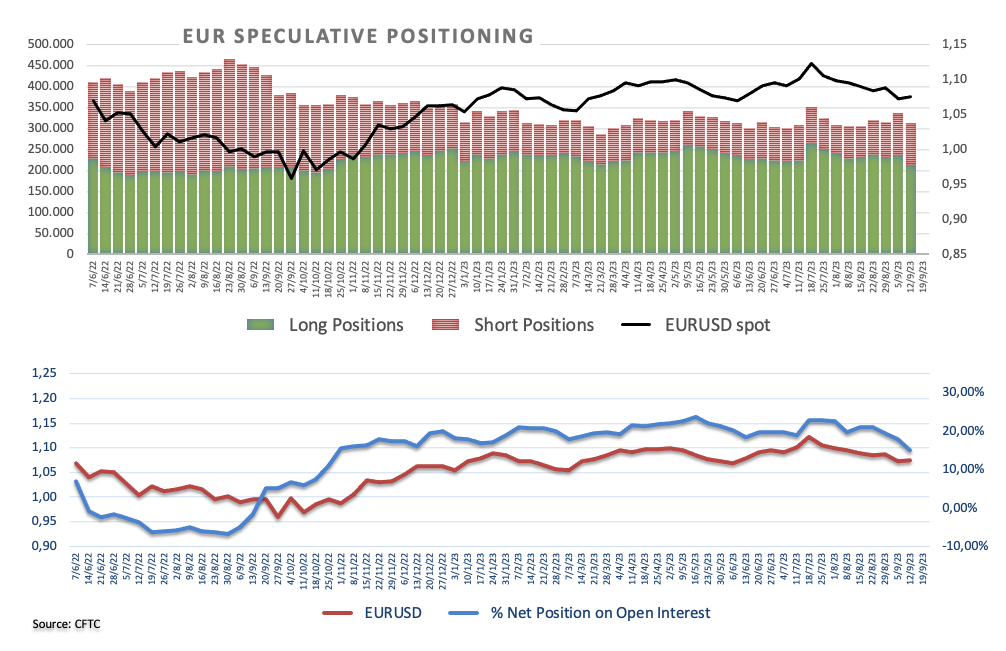Euro’s recovery meets some decent hurdle ahead of 1.0670
- The Euro loses some buying pressure against the US Dollar.
- Stocks in Europe kicked off the week in the red.
- EUR/USD remains below 1.0700.
- The USD Index (DXY) holds above the 105.00 hurdle.
- The FOMC gathering will be the salient event this week.
- The US NAHB index will take centre stage later in the session.
The Euro (EUR) alternates gains with losses against the US Dollar (USD) at the beginning of the week, prompting EUR/USD to trade around the 1.0660 region early in the European morning.
The Greenback appears to be under tepid downside pressure, although it manages to keep the trade above the key 105.00 barrier amidst the persistent upside bias in US yields across different timeframes.
With regards to monetary policy, investors continue to assess last week’s dovish hike by the European Central Bank (ECB) and persist in anticipating the possibility of interest-rate reductions by the Federal Reserve (Fed) occurring in the second quarter of 2024.
On another front, EUR net longs extended the downtrend and reached levels last seen in mid-November 2022, according to the latest positioning report by the CFTC for the week ended on September 12. The period under study saw the pair climb to the 1.0750 region and quickly lose ground soon afterwards the ECB event on September 14.
The absence of data releases in the euro docket should shift attention to the US calendar, where the NAHB Housing Price Index and Long-Term TIC Flows are due in the American session.
Daily digest market movers: Euro appears under scrutiny ahead of Fed
- The EUR has been unable to gather fresh strength against the USD.
- US and German yields have started the week in a positive mood.
- Investors see the Fed keeping rates unchanged this week.
- Fitch agency confirms Germany’s AAA rating with a stable outlook.
- Traders see potential rate cuts by the Fed in H1 2024.
- Expectations of an impasse in the ECB’s hiking cycle appears to be gathering traction.
Technical Analysis: Euro does not rule out extra weakness in near term
EUR/USD looks to extend Friday’s rebound from multi-week lows near 1.0630.
If the EUR/USD breaks below its September 15 low of 1.0631, it may revisit the March 15 low of 1.0516 before reaching the 2023 bottom of 1.0481 seen on January 6.
On the upside, the critical 200-day Simple Moving Average (SMA) is located at 1.0827. Bullish momentum may develop if the pair breaks through this key barrier, leading it to a test of the provisional 55-day SMA at 1.0922 ahead of the August 30 high of 1.0945. This scenario may open the way for a rally towards the psychological level of 1.1000 and the August 10 top of 1.1064. If the pair clears this region, it may relieve some of the bearish pressure and go for the July 27 peak at 1.1149, followed by the 2023 high at 1.1275 from July 18.
As long as the EUR/USD is below the 200-day SMA, the pair might continue to fall.
Euro FAQs
The Euro is the currency for the 20 European Union countries that belong to the Eurozone. It is the second most heavily traded currency in the world behind the US Dollar. In 2022, it accounted for 31% of all foreign exchange transactions, with an average daily turnover of over $2.2 trillion a day.
EUR/USD is the most heavily traded currency pair in the world, accounting for an estimated 30% off all transactions, followed by EUR/JPY (4%), EUR/GBP (3%) and EUR/AUD (2%).
The European Central Bank (ECB) in Frankfurt, Germany, is the reserve bank for the Eurozone. The ECB sets interest rates and manages monetary policy.
The ECB’s primary mandate is to maintain price stability, which means either controlling inflation or stimulating growth. Its primary tool is the raising or lowering of interest rates. Relatively high interest rates – or the expectation of higher rates – will usually benefit the Euro and vice versa.
The ECB Governing Council makes monetary policy decisions at meetings held eight times a year. Decisions are made by heads of the Eurozone national banks and six permanent members, including the President of the ECB, Christine Lagarde.
Eurozone inflation data, measured by the Harmonized Index of Consumer Prices (HICP), is an important econometric for the Euro. If inflation rises more than expected, especially if above the ECB’s 2% target, it obliges the ECB to raise interest rates to bring it back under control.
Relatively high interest rates compared to its counterparts will usually benefit the Euro, as it makes the region more attractive as a place for global investors to park their money.
Data releases gauge the health of the economy and can impact on the Euro. Indicators such as GDP, Manufacturing and Services PMIs, employment, and consumer sentiment surveys can all influence the direction of the single currency.
A strong economy is good for the Euro. Not only does it attract more foreign investment but it may encourage the ECB to put up interest rates, which will directly strengthen the Euro. Otherwise, if economic data is weak, the Euro is likely to fall.
Economic data for the four largest economies in the euro area (Germany, France, Italy and Spain) are especially significant, as they account for 75% of the Eurozone’s economy.
Another significant data release for the Euro is the Trade Balance. This indicator measures the difference between what a country earns from its exports and what it spends on imports over a given period.
If a country produces highly sought after exports then its currency will gain in value purely from the extra demand created from foreign buyers seeking to purchase these goods. Therefore, a positive net Trade Balance strengthens a currency and vice versa for a negative balance.



Comments are closed.